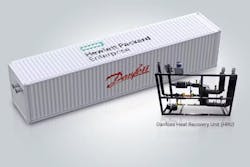Danfoss, HPE Integrate Heat Recovery, Modular Data Center Containers to Quench AI Energy Gulp
Energy demand from the AI industry could rise by a factor of 10 over last year’s consumption rate. To meet this surge, Hewlett Packard Enterprise (HPE) and Danish multi-national company Danfoss report that they’ve integrated a new technology solution to provide heat reuse module systems in conjunction with HPE’s scalable modular data center containers.
The Sustainable AI Data Center Conundrum
According to a recent International Energy Agency (IEA) report, the AI industry is expected to consume at least ten times its 2023 electricity demand by 2026. This could mean that AI data centers might stand to consume 20–25% of the U.S.'s power requirements by the end of the decade.
Meanwhile, an April 2024 report by Goldman Sachs recently estimated some 47 GW of coming data center construction in the U.S. over the next decade. This will increase load demand for both electricity and heat recovery technologies by many terawatt hours (TWh) or thousands of gigawatt hours.
Such future power load forecasts resulting from the exponential growth in data center and artificial intelligence (AI) capacity wields a double-edged sword for utilities, as well as combined heat and power generators and microgrid developers.
It sounds like money in the data bank, but also presents huge infrastructural challenges.
Data centers generate tremendous amounts of heat. Excess heat in the European Union alone totals close to 2,860 TWh per year, according to reports.
But according to sources cited by an HPE document, energy efficiency experts see excess heat as “the world’s largest untapped energy source,” and a method to achieve greater efficiency.
Danfoss Heat Recovery Module Promotes Sustainability
Earlier this summer, Hewlett Packard Enterprise and global equipment manufacturer and supplier Danfoss announced plans to collaborate on Heat Recovery Unit (HRU) module technology called on to furnish the HPE IT Sustainability Services brand.
HPE and Danfoss in June said they’ve designed the new technology solution to provide heat reuse modules and HPE’s scalable modular data center containers.
“Our strategic partnership with HPE is a great example of how we revolutionize building and decarbonizing the data center industry together with customers,” Jurgen Fischer, president of Danfoss Climate Solutions, said in a statement. “With this latest cross-industry partnership we’re building the blueprint for the next generation of sustainable data centers—using technologies available today.”
Modular Edge Data Centers for AI
In the emerging world of AI, ML and IoT, the low latency and locational advantages of edge and remote computing most likely become not just nice-to-have, but must-have propositions.
In his insightful recent LinkedIn post entitled, "Embracing the Micro Data Center Revolution," noted data center industry influencer and distinguished business and technology leader Tony Grayson, who presently serves as Veteran's Chair at Infrastructure Masons (iMasons) and Compass Datacenters' GM in Seattle, contends that "the shift towards micro data centers (DCs) is beginning to happen."
Grayson opines that adopting micro DCs offers a compelling proposition that offers more than just scalability, but critical flexibility and responsiveness to the changing demands of the digital world. He writes, "When it's time for an upgrade or expansion, deploying a new set of micro DCs can be more straightforward and potentially more cost-effective than retrofitting an outdated infrastructure."
Grayson continues:
"The pace of change in our industry is staggering, rendering traditional long-term planning less effective. As we look ahead, it's becoming increasingly clear that building for the 'what ifs' of 3-5 years down the line is a gamble many are missing the mark on [so] think of micro DCs as consumable equipment, akin to the servers they house. They have a usable lifespan. By the time a server reaches the end of its life, the technological and operational requirements will have evolved to the point where a new facility design becomes not just a necessity but an opportunity for innovation."
Data Center Frontier Trends Summit Alert
At next month's Data Center Frontier Trends Summit (Sept. 4-6) in Reston, Virginia on Monday, Sept. 4 from 3:10 pm - 4:00 pm, Tony Grayson will debut a technical intelligence paper for data center industry stakeholders entitled, "Why Modular Data Centers Are Critical to the Future of Enterprise and Defense Digital Infrastructure."
The thesis of Grayson's paper to be presented at the DCF Trends Summit is thus:
"The evolution of edge and by association, modular data centers has not met initial expectations, largely due to an insufficient network infrastructure and the lack of a commercially viable platform that requires local compute. Despite this, there's a new shift towards modular solutions that adhere to hyperscale standards, a trend that is being adopted by enterprises, the Department of Defense, and various federal and state agencies.
This shift is driven by several factors, including but not limited to the rapid advancement of technology, the increasing need for a shorter time to market, the growing demands of powering and cooling for AI, sustainability requirements, data sovereignty, and local power limitations. While this trend towards modular data centers is increasing, it remains under the radar, overshadowed by the industry's focus on AI and the growth of large hyperscale data center campuses. This paper explores the factors that are making customers choose modular data center solutions over traditional on premise, retail, or wholesale spaces."
At the Trends Summit, a formal response to Grayson's paper will be presented by Maureen Russell, Acting Deputy Associate Administrator, Telecommunications for the National Telecommunications and Information Administration's (NTIA) Office of Policy Development and Analysis (OPAD).
OPAD develops, analyzes, and advocates Internet and communications-related public policies that promote digital inclusion, innovation, competition, jobs, and economic growth for the benefit of the American populace, and supports the NTIA's agency as the principal adviser to the President on telecommunications aind information policy.
To date, the NTIA has allocated more than $42.45 billion across 56 states and territories as part of the Broadband Equity, Access, and Deployment (BEAD) Program, which is providing $42.45 billion in funding to expand high-speed internet access across America by funding planning, infrastructure deployment (much of it fiber-optic and of the route miles variety) and adoption programs in all 50 states, Washington D.C., Puerto Rico, the U.S. Virgin Islands, Guam, American Samoa, and the Commonwealth of the Northern Mariana Islands.
In a recent guest article for Data Center Frontier as part of our Voices of the Industry forum, iMiller Public Relations Founder and CEO Ilissa Miller analyzes how federal broadband mandates are driving the need for connectivity hubs to support U.S. data centers.
Sustainability In Action at Danfoss
Danfoss already utilizes heat reuse technology at its own headquarters campus in Denmark. The heat is recovered from Danfoss’ on-site data center and circulated by a heat pump to other nearby buildings for space heating.
Danfoss already produces grid converter-power conversion technologies used to facilitate smart grid interconnection with battery storage assets and microgrids.
Because as everyone knows, it's not just the data center industry who's in a race to decarbonize. Heating and cooking in residential and commercial buildings accounts for 6% of global carbon dioxide emissions, according to research and management consulting firm McKinsey.
About the Author

Rod Walton
Rod Walton is Managing Editor of Endeavor Business Media's Microgrid Knowledge and EnergyTech, publications focused on the sustainability and resiliency goals of mission-critical and large-scale energy users, including the commercial and industrial sectors, as well as the military, universities and data centers.
Matt Vincent
A B2B technology journalist and editor with more than two decades of experience, Matt Vincent is Editor in Chief of Data Center Frontier.




